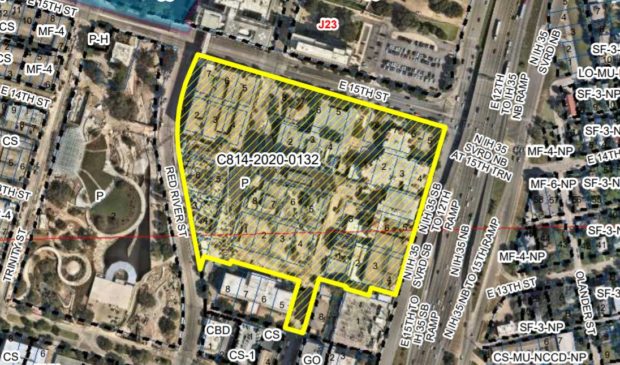Planning Commission recommends PUD zoning for Brackenridge Hospital tract
Friday, May 14, 2021 by
Jonathan Lee The Planning Commission Tuesday recommended Planned Unit Development (PUD) zoning for the tract that was formerly home to Brackenridge Hospital, bringing one of the biggest downtown redevelopment projects one step closer to design and construction.
Owner Central Health is planning to lease its 14-acre site at 601 E. 15th St. to a developer, giving the health care provider a long-term income source. “This property is pretty crucial to Central Health and its future income to be able to perform its mission,” said Nikelle Meade, agent for Central Health. The city, with the support of Central Health, initiated the PUD zoning request. The site is currently zoned Public Use (P).
The whole northeast quadrant of downtown, dubbed the Innovation District, is booming with new development. Two towers are planned on the HealthSouth site, which is adjacent to the Central Health PUD, and three other towers are already under construction nearby. On top of that, Waterloo Park is scheduled to reopen in August after $150 million in renovations.
Central Health is seeking PUD zoning that is nearly identical to Central Business District (CBD) zoning, which means no height or impervious cover limits. But because it is still early in the process, Meade said, “We don’t have any idea yet how the development will lay out on the site.”
Whatever ends up there is likely to be dense and tall. “The whole idea behind redeveloping this tract is to be able to maximize density,” Meade said, which will “maximize the revenue that Central Health will generate.”
The main difference between CBD zoning and the requested PUD zoning involves loosening floor area ratio maximums to allow taller and denser buildings. CBD zoning caps FAR at 8:1 and offers additional FAR through the Downtown Density Bonus program. The zoning for the PUD, however, would allow up to 25:1 FAR without a density bonus and unlimited FAR with a bonus.
The project so far has taken a winding route through the city’s approval process. City Council outlined its goals for redevelopment of the site in 2014. Five years later, in 2019, the Planning Commission recommended Central Health’s and the city’s request to add an overlay atop the existing zoning in order to outline the site’s development standards. Council then changed its mind on the overlay, voting instead to initiate a PUD rezoning process with the exact same site development standards as outlined in the overlay request. Only now has the case returned to the Planning Commission.
Commissioners supported the project, but wanted to make sure that the redevelopment created the most walkable, pedestrian-friendly streetscapes possible.
The applicant has requested that certain pedestrian improvement standards attached to CBD zoning be waived, explained Jerry Rusthoven with the Housing and Planning Department, because total compliance with such requirements may not be possible.
“I fully anticipate that they would be doing pedestrian-oriented uses for much of the property,” Rusthoven assured the commission. “I mean, it just makes economic sense downtown.” He also said that the development “will be doing Great Streets, just not 100 percent.”
Central Health is also paying to realign Red River Street between 12th and 15th streets – an important city mobility goal that will add pedestrian space along the former right of way along Waller Creek.
Despite Rustoven’s assurances, Commissioner James Shieh motioned to add certain pedestrian and streetscape standards to the PUD. He also moved to second the Environmental Commission’s recommendation that all buildings comply with 3-star Austin Energy Green Building Standards.
The commission voted 10-0-2 in favor of Shieh’s motion. Commissioners Awais Azhar and Joao Paulo Connolly abstained, considering the additional pedestrian requirements unnecessary.
Council is scheduled to vote on the case on May 20.
The Austin Monitor’s work is made possible by donations from the community. Though our reporting covers donors from time to time, we are careful to keep business and editorial efforts separate while maintaining transparency. A complete list of donors is available here, and our code of ethics is explained here.
You're a community leader
And we’re honored you look to us for serious, in-depth news. You know a strong community needs local and dedicated watchdog reporting. We’re here for you and that won’t change. Now will you take the powerful next step and support our nonprofit news organization?



